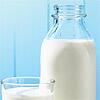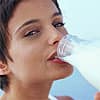
What's Hot
What's Hot
| News flashes are posted here frequently to keep you up-to-date with the latest advances in health and longevity. We have an unparalleled track record of breaking stories about life extension advances.
How much vitamin D do we need?
One hundred thirty-eight men and women with baseline serum values of 25-hydroxyvitamin D [25(OH)D] of less than 80 nanomoles per liter (nmol/L) were included in the current study. Optimal levels of 25(OH)D have been proposed to be at least 75 nanomoles per liter by U.S. experts, with an upper limit of 220 nmol/L. In order to determine the amount of supplemental vitamin D3 necessary to achieve this concentration, participants whose serum concentrations of the vitamin were greater than 50 nmol/L were started on 2,000 IU per day or a placebo, and those whose levels were below 50 nmol/L were given 4000 IU or a placebo. Follow up visits occurred at eight week intervals over the six month study period, during which serum vitamin D levels were assessed and vitamin D dosage adjusted accordingly. All of the subjects who received vitamin D were able to attain the target level by the end of the study. No evidence of toxicity of the doses administered was observed. The authors note that the selection of 2000 IU vitamin D per day as a safe tolerable upper intake level by the Food and Nutrition Board is now considered to be based on insufficient evidence. According to the current study's findings, the authors suggest that individuals whose 25-hydroxyvitamin D levels are above 55 nmol/L consume 3800 IU per day vitamin D to achieve optimal serum levels, and that those whose levels are less than 55 nmol/L consume 5000 IU. —D Dye Coffee lovers have less liver cancer
Gang Hu at the University of Helsinki and his Finnish colleagues analyzed data from 60,323 Finnish men and women aged 25 to 74 who were included in seven independent population surveys conducted between 1972 and 2002. Participants were free of cancer upon enrollment, and followed up for a median of 19.3 years. Information concerning serum levels of the liver enzyme gamma-glutamyltransferase (GGT) was available for a subgroup of subjects. Data from the Finnish Cancer Registry was used to confirm cancer diagnoses. During the follow-up period, 128 cases of liver cancer were diagnosed. Liver cancer diagnoses declined as the number of cups of coffee consumed per day increased. Participants who reported drinking eight or more cups of coffee per day had a 62 percent lower risk of developing liver cancer than those who drank zero to one cups per day. Among subjects for whom serum GGT levels were available, those whose levels were among the highest 25 percent experienced over three times the risk of developing liver cancer compared with those whose levels fell in the lowest quarter of participants. “Nevertheless,” the authors note, “the inverse association between coffee consumption and the risk of liver cancer was consistent in the subjects at any level of serum GGT.” In an accompanying editorial, Carlo La Vecchia of the Università degli Studi di Milano added, “It remains difficult, however, to translate the inverse relation between coffee drinking and liver cancer risk observed in epidemiological studies into potential implications for prevention of liver cancer by increasing coffee consumption." —D Dye Grape seed extract reduces cognitive decline in animal model of Alzheimer's disease
For the current study, Giulio Pasinetti, MD, PhD, of Mount Sinai's Departments of Psychiatry and Neuroscience, and his associates used mice that were genetically modified to develop Alzheimer's disease. The animals were divided to receive a polyphenolic grape seed extract or a placebo for five months prior to the usual age at which signs of the disease develop. The dose of extract used in the study was equivalent to the daily amount of polyphenolics consumed by the average person. At the end of the treatment period, beta-amyloid accumulation was significantly reduced in the brains of animals that received the polyphenolic extract compared with the placebo group. The animals also demonstrated improved spatial memory compared with those that did not receive the extract, indicating less cognitive decline. In previous experimentation conducted by Dr Pasinetti, red wine was found to limit cognitive decline in the Alzheimer's disease mouse model. Research carried out by Dr Pasinetti's team has sought to identify the compounds in red wine's nearly 5,000 molecules that are responsible for its benefits. "Our intent is to develop a highly tolerable, nontoxic, orally available treatment for the prevention and treatment of Alzeheimer's dementia," Dr Pasinetti stated. Future research may determine whether grape polyphenols can be used to treat human Alzheimer's disease patients. —D Dye Dementia not inevitable
Prof. dr. Gert Holstege of University Medical Centre Groningen, The Netherlands and colleagues examined the brain and body of a Dutch woman who had willed her body to research at the age of 82. The woman had lived independently until the age of 105, when she moved to a residential care home because of poor eyesight. Neurological and psychological examinations conducted at age 112 and 113 determined that the woman had no memory or attention problems, and that her general mental performance was considered above average for someone between the ages of 60 to 75. She remained mentally alert until her death as the world's oldest woman at the age of 115. Upon examination of the brain, the number of brain cells found was estimated to be that of a healthy person 60 to 80 years of age. Of the signs of Alzheimer's disease, almost no beta-amyloid deposits and only a mild degree of neurofibrillary tangles were found, considered to be too early to cause mental impairment. No evidence of atherosclerosis was observed in the brain or body. In a commentary published in the same issue of the journal, Joseph L. Price noted several similar findings in nondemented individuals aged 85 to 105. "Are there limits to the duration of high quality of life? Are there limits to healthy life for a human brain?" the authors ask in their introduction. "Our observations indicate that the limits of human cognitive function extends far beyond the range that is currently enjoyed by most individuals and that brain disease, even in supercentanarians, is not inevitable," they conclude. —D Dye Higher vitamin D levels associated with improved colon cancer patient survival
The current study included 304 participants in the Nurses' Health Study and the Health Professionals Follow-Up Study who were diagnosed with colorectal cancer between 1991 and 2002. Blood samples collected at least two years prior to diagnosis were analyzed for plasma 25-hydroxyvitamin D. Participants in the Nurses' Health Study were followed until June, 2005, and those in the Health Professionals Follow-Up Study were followed until January, 2005, during which time there were 123 deaths, including 96 from colon cancer. The researchers, led by Kimmie Ng, MD, MPH and Charles Fuchs, MD, MPH, found that subjects whose vitamin D levels were in the highest 25 percent of participants had a 39 percent lower risk of dying of colon cancer and a 48 percent lower risk of dying from any cause compared to those whose levels fell in the lowest 25 percent, who were considered deficient. Exclusion of patients whose blood samples were collected within five years of diagnosis failed to alter the results. Dr Ng announced an upcoming clinical trial of vitamin D combined with chemotherapy to be administered following surgery for colon cancer to evaluate the benefits of supplementation. She suggests that colon cancer patients consult with their physicians concerning the advisability of adding the vitamin to their regimen. "Our data suggest that higher prediagnosis plasma levels of 25-hydroxyvitamin D after a diagnosis of colorectal cancer may significantly improve overall survival," the authors write. "Future trials should examine the role of vitamin D supplementation in patients with colorectal cancer." —D Dye Omega-3 fatty acids associated with protection against macular degeneration
"Docosahexaenoic acid (DHA) is present in high concentrations in the retinal outer segments, and its deficiency may initiate the onset of AMD," the authors write in their introduction. "Long-chain omega-3 fatty acids may also protect against oxygenic, inflammatory, and age-related retinal damage,16 which are key pathogenic processes in AMD development." Elaine W-T. Chong, MBBS, of the University of Melbourne, Australia, and her associates selected 3 prospective cohort, 3 case-control, and 3 cross-sectional studies published prior to May, 2007 for the current review. The studies involved a total of 88,974 men and women, including 3,203 with age-related macular degeneration. Analysis of the nine studies found a 38 percent reduction in the risk of late (advanced) AMD associated with a high intake of omega-3 fatty acids compared to those whose intake was lowest. The relationship of omega-3 fatty acid intake to early AMD was not analyzed due to limited data. Eating fish was also associated with a reduced risk of late AMD. Participants whose fish consumption was highest at twice or more per week experienced a risk of late AMD that was a third lower than those whose intake was lowest. Additionally, subjects whose fish intake was highest had a 24 percent lower risk of early macular degeneration compared with the lowest group. "These results suggest that high dietary intakes of omega-3 fatty acids and fish are associated with a reduced risk of both early and late AMD," the authors conclude. —D Dye Probiotic improves immune response in seasonal allergy patients
Probiotics contain beneficial bacteria found in the human intestines. Intestinal microflora alterations have been implicated in the development of allergies, which suggests reactions between the intestine's immune system and specific bacteria. In a double-blind trial, Professor Claudio Nicoletti and his associates at England's Institute of Food Research provided 20 hay fever sufferers with a milk drink containing live probiotic bacteria, or a drink containing no bacteria, to be consumed for a five month period encompassing grass pollen season. Blood samples collected before the study, at the peak of grass pollen season in June, and four weeks and after treatment were analyzed for immune system proteins known as cytokines, and plasma antibodies IgE and IgG. While IgG is believed to play a protective role against allergic reactions, IgE produces the symptoms of hay fever by stimulating histamine release in response to pollen or fungal spores. Among those who received the probiotic-containing drink there was an increase in IgG, and a reduction IgE, antigen-induced interleukin-5, interleukin-6 and and interferon-gamma production compared with those who received the placebo. "This was a pilot study based on small numbers of patients, but we were fascinated to discover a response", Dr Nicoletti stated. "The probiotic significantly reduced the production of molecules associated with allergy." Kamal Ivory, who is the report's first author, concluded, "The probiotic strain we tested changed the way the body's immune cells respond to grass pollen, restoring a more balanced immune response." —D Dye More evidence for vitamin D's protective role against childhood diabetes
Cedric F. Garland, DrPH, who is a professor of Family and Preventive Medicine in the UC San Diego School of Medicine, and his colleagues examined diabetes type 1 rates in 51 regions, and, after adjusting for cloud cover and per capital health care expenditure, found a lower risk of the disease in areas near the equator where sun exposure is greater, and an increased risk at higher latitudes. In regions with high UVB radiance, the incidence of type 1 diabetes approached zero. "This is the first study, to our knowledge, to show that higher serum levels of vitamin D are associated with reduced incidence rates of type 1 diabetes worldwide," Dr Garland stated. "This research suggests that childhood type 1 diabetes may be preventable with a modest intake of vitamin D3 (1000 IU/day) for children, ideally with 5 to 10 minutes of sunlight around noontime, when good weather allows. Infants less than a year old should not be given more than 400 IU per day without consulting a doctor. Hats and dark glasses are a good idea to wear when in the sun at any age, and can be used if the child will tolerate them." "This study presents strong epidemiological evidence to suggest that we may be able to prevent new cases of type 1 diabetes," Dr Garland concluded. "By preventing this disease, we would prevent its many devastating consequences." —D Dye Metformin increases treatment response rate of diabetics undergoing chemotherapy
Ana M. Gonzalez-Angulo, MD and Jay Jirlerspong, MD, PhD of M.D. Anderson's Department of Breast Medical Oncology presented the results of a retrospective study which evaluated 2,529 women who underwent chemotherapy prior to surgery for early stage breast cancer. Of the subjects, 2,374 were nondiabetic, 87 had diabetes treated with Metformin, and 68 had diabetes that was not treated with the drug. Pathologic complete response rates (defined as the absence of cancer cells in the removed tissue) in diabetics not taking Metformin was 8 percent, which was half the rate of response of nondiabetic women. Among diabetics taking Metformin, however, the response rate was 24 percent. "Metformin has a novel mechanism of action," Dr Jiralerspong stated. "There have been a number of papers published recently that describe its action through activation of the AMP kinase pathway, which is a cellular energy sensor of the cells and potentially important pathway for the development of cancer." "The other interesting aspect is that Metformin works by decreasing the amount of insulin- resistance in diabetics and insulin seems to be a growth factor for cancer," added Dr Gonzalez-Angulo. "We need to study the mechanism of the drug - perhaps it's the decrease in insulin levels, or it may be that the drug has an anti-tumor effect that we to look at in vivo. Our next step is to conduct a number correlative studies to try and further understand its mechanism." —D Dye Dehydrated tomato compound protects against prostate cancer
Using rats that had been injected with a carcinogen and testosterone to induce prostate cancer, Valeri V. Mossine and colleagues administered diets supplemented with tomato paste, tomato paste plus FruHis, a member of a group of carbohydrate derivatives known as ketosamines, found in dried tomatoes; or tomato powder (which contains a small, naturally occurring amount of FruHis) for 51 weeks. A control group of animals received unsupplemented diets. Among rats that developed tumors, those fed the control diet experienced a median survival time of 40 weeks following administration of the carcinogen, compared with a median of 50 weeks in the tomato powder group and 51 weeks in the group that received tomato paste with added FruHis. The number of animals with tumors at other sites than the prostate was similar among the groups that received tomato supplemented diets, yet among animals that died during the study, macroscopic prostate tumors were found in 39 percent of those that received tomato paste alone, 43 percent of the tomato powder group and just 18 percent of the animals that received the tomato paste/FruHis combination, in contrast with 63 percent of the controls. “Before this study, researchers attributed the protective effect of tomatoes to ascorbic acid, carotenoids or phenolic compounds," noted Dr Massene, who is a research assistant professor of biochemistry in the College of Agriculture, Food and Natural Resources at the University. "FruHis may represent a novel type of potential dietary antioxidant. Our ongoing research now focuses on unraveling the mechanisms behind why this has a beneficial effect. This knowledge may lead to other avenues of research and drug development for prostate and other cancers. Results of this study certainly warrant clinical trials.” —D Dye |

 Research conducted at Winthrop University Hospital in Mineola, New York, has determined that individuals with vitamin D insufficiency need an average dose of 3800 to 5000 international units (IU) per day in order to attain optimal levels. The findings were published in the June, 2008 issue of the
Research conducted at Winthrop University Hospital in Mineola, New York, has determined that individuals with vitamin D insufficiency need an average dose of 3800 to 5000 international units (IU) per day in order to attain optimal levels. The findings were published in the June, 2008 issue of the  A report published in the July, 2008 issue of the journal
A report published in the July, 2008 issue of the journal  The June 18, 2008 issue of
The June 18, 2008 issue of  A brief communication published in the August, 2008 issue of
A brief communication published in the August, 2008 issue of  The June 20, 2008 of the
The June 20, 2008 of the  The June, 2008 issue of the AMA journal
The June, 2008 issue of the AMA journal  An article published online on May 28, 2008 in the journal
An article published online on May 28, 2008 in the journal  Research conducted at the University of Texas M.D. Anderson Cancer Center has found that diabetic
Research conducted at the University of Texas M.D. Anderson Cancer Center has found that diabetic  The June 1, 2008 issue of
The June 1, 2008 issue of 